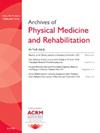5% 葡萄糖注射液和皮质类固醇注射液治疗腕管综合征的疗效比较:系统回顾与元分析》。
IF 3.6
2区 医学
Q1 REHABILITATION
Archives of physical medicine and rehabilitation
Pub Date : 2025-02-01
DOI:10.1016/j.apmr.2024.07.005
引用次数: 0
摘要
研究目的本研究旨在评估5%葡萄糖(D5W)与皮质类固醇治疗腕管综合征(CTS)的有效性:数据来源:2023 年 11 月 13 日,在 MEDLINE (PubMed)、Embase 和 Cochrane Central Register of Controlled Trials 中进行了全面的系统检索。此外,还使用谷歌学术(Google Scholar)进行了人工检索:两位独立作者对文献进行了审阅,并通过详细讨论和咨询第三位作者来解决任何差异:两位作者独立提取了主要结果(疼痛评估)和次要结果(使用波士顿腕管问卷调查的症状严重程度和功能状态、电生理测量、横截面积和不良反应)的数据:分析包括 4 项随机对照试验和 1 项准实验研究,共涉及 212 名轻度至中度 CTS 患者(220 只手):3个月内,与皮质类固醇相比,D5W注射剂对功能状态的改善具有统计学意义,标准平均差为-0.34(95%置信区间(CI),-0.62至-0.05)。与皮质类固醇相比,D5W的不良反应较少(风险比为0.13;95% CI为0.03至0.51)。两种疗法在其他方面没有差异:结论:对于轻度至中度 CTS 患者,D5W 注射在改善功能状态方面比皮质类固醇注射更有效,且不良反应更少。在减轻疼痛、症状严重程度、电诊断测量和神经横截面积方面,D5W 注射也与皮质类固醇注射效果相当,因此建议将 D5W 作为轻度至中度 CTS 的首选治疗方法。本文章由计算机程序翻译,如有差异,请以英文原文为准。
Comparative Efficacy of 5% Dextrose and Corticosteroid Injections in Carpal Tunnel Syndrome: A Systematic Review and Meta-analysis
Objective
This study aims to assess the effectiveness of 5% dextrose (D5W) in comparison to corticosteroids for treating carpal tunnel syndrome (CTS).
Data Sources
A comprehensive systematic search was conducted across MEDLINE (PubMed), Embase, and the Cochrane Central Register of Controlled Trials on November 13, 2023. These were supplemented by manual searches using Google Scholar.
Study Selection
Two independent authors reviewed the literature, resolving any discrepancies through detailed discussions and consultation with a third author.
Data Extraction
Data on primary outcomes (pain assessment) and secondary outcomes (symptom severity and functional status using the Boston Carpal Tunnel Questionnaire, electrophysiologic measures, cross-sectional area, and adverse effects) were extracted independently by the 2 authors (M.W. and H.H.).
Data Synthesis
The analysis included 4 randomized controlled trials and 1 quasi-experimental study, encompassing a total of 212 patients (220 hands) with mild to moderate CTS.
Results
Within 3 months, the D5W injections showed a statistically significant improvement in functional status compared to the corticosteroids with a standard mean difference of −0.34 (95% CI, −0.62 to −0.05). D5W was associated with fewer adverse incidents than corticosteroids (risk ratio, 0.13; 95% CI: 0.03-0.51). No difference was observed between the 2 treatments in other areas.
Conclusions
For patients with mild to moderate CTS, D5W injections were more effective than corticosteroid injections in improving functional status and demonstrated fewer adverse effects. D5W injections also paralleled corticosteroids in pain reduction, symptom severity, electrodiagnostic measures, and cross-sectional area of nerve, recommending D5W as a preferred treatment for mild to moderate CTS.
求助全文
通过发布文献求助,成功后即可免费获取论文全文。
去求助
来源期刊
CiteScore
6.20
自引率
4.70%
发文量
495
审稿时长
38 days
期刊介绍:
The Archives of Physical Medicine and Rehabilitation publishes original, peer-reviewed research and clinical reports on important trends and developments in physical medicine and rehabilitation and related fields. This international journal brings researchers and clinicians authoritative information on the therapeutic utilization of physical, behavioral and pharmaceutical agents in providing comprehensive care for individuals with chronic illness and disabilities.
Archives began publication in 1920, publishes monthly, and is the official journal of the American Congress of Rehabilitation Medicine. Its papers are cited more often than any other rehabilitation journal.

 求助内容:
求助内容: 应助结果提醒方式:
应助结果提醒方式:


